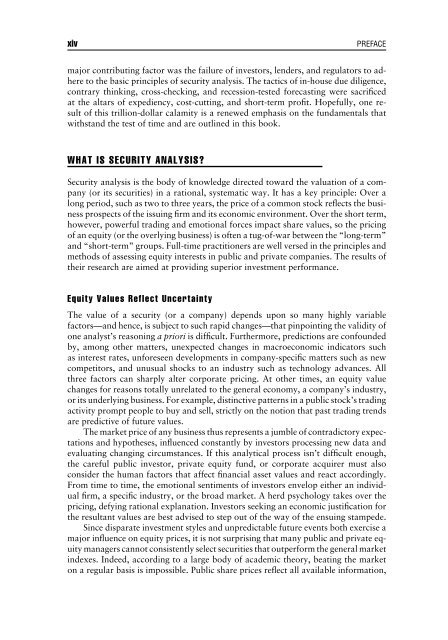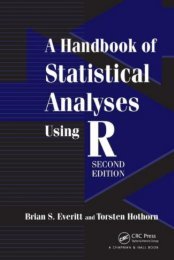Security Analysis and Business Valuation on Wall Street,: A ... - lib
Security Analysis and Business Valuation on Wall Street,: A ... - lib
Security Analysis and Business Valuation on Wall Street,: A ... - lib
Create successful ePaper yourself
Turn your PDF publications into a flip-book with our unique Google optimized e-Paper software.
xivPREFACEmajor c<strong>on</strong>tributing factor was the failure of investors, lenders, <str<strong>on</strong>g>and</str<strong>on</strong>g> regulators to adhereto the basic principles of security analysis. The tactics of in-house due diligence,c<strong>on</strong>trary thinking, cross-checking, <str<strong>on</strong>g>and</str<strong>on</strong>g> recessi<strong>on</strong>-tested forecasting were sacrificedat the altars of expediency, cost-cutting, <str<strong>on</strong>g>and</str<strong>on</strong>g> short-term profit. Hopefully, <strong>on</strong>e resultof this trilli<strong>on</strong>-dollar calamity is a renewed emphasis <strong>on</strong> the fundamentals thatwithst<str<strong>on</strong>g>and</str<strong>on</strong>g> the test of time <str<strong>on</strong>g>and</str<strong>on</strong>g> are outlined in this book.WHAT IS SECURITY ANALYSIS?<str<strong>on</strong>g>Security</str<strong>on</strong>g> analysis is the body of knowledge directed toward the valuati<strong>on</strong> of a company(or its securities) in a rati<strong>on</strong>al, systematic way. It has a key principle: Over al<strong>on</strong>g period, such as two to three years, the price of a comm<strong>on</strong> stock reflects the businessprospects of the issuing firm <str<strong>on</strong>g>and</str<strong>on</strong>g> its ec<strong>on</strong>omic envir<strong>on</strong>ment. Over the short term,however, powerful trading <str<strong>on</strong>g>and</str<strong>on</strong>g> emoti<strong>on</strong>al forces impact share values, so the pricingof an equity (or the overlying business) is often a tug-of-war between the “l<strong>on</strong>g-term”<str<strong>on</strong>g>and</str<strong>on</strong>g> “short-term” groups. Full-time practiti<strong>on</strong>ers are well versed in the principles <str<strong>on</strong>g>and</str<strong>on</strong>g>methods of assessing equity interests in public <str<strong>on</strong>g>and</str<strong>on</strong>g> private companies. The results oftheir research are aimed at providing superior investment performance.Equity Values Reflect UncertaintyThe value of a security (or a company) depends up<strong>on</strong> so many highly variablefactors—<str<strong>on</strong>g>and</str<strong>on</strong>g> hence, is subject to such rapid changes—that pinpointing the validity of<strong>on</strong>e analyst’s reas<strong>on</strong>ing aprioriis difficult. Furthermore, predicti<strong>on</strong>s are c<strong>on</strong>foundedby, am<strong>on</strong>g other matters, unexpected changes in macroec<strong>on</strong>omic indicators suchas interest rates, unforeseen developments in company-specific matters such as newcompetitors, <str<strong>on</strong>g>and</str<strong>on</strong>g> unusual shocks to an industry such as technology advances. Allthree factors can sharply alter corporate pricing. At other times, an equity valuechanges for reas<strong>on</strong>s totally unrelated to the general ec<strong>on</strong>omy, a company’s industry,or its underlying business. For example, distinctive patterns in a public stock’s tradingactivity prompt people to buy <str<strong>on</strong>g>and</str<strong>on</strong>g> sell, strictly <strong>on</strong> the noti<strong>on</strong> that past trading trendsare predictive of future values.The market price of any business thus represents a jumble of c<strong>on</strong>tradictory expectati<strong>on</strong>s<str<strong>on</strong>g>and</str<strong>on</strong>g> hypotheses, influenced c<strong>on</strong>stantly by investors processing new data <str<strong>on</strong>g>and</str<strong>on</strong>g>evaluating changing circumstances. If this analytical process isn’t difficult enough,the careful public investor, private equity fund, or corporate acquirer must alsoc<strong>on</strong>sider the human factors that affect financial asset values <str<strong>on</strong>g>and</str<strong>on</strong>g> react accordingly.From time to time, the emoti<strong>on</strong>al sentiments of investors envelop either an individualfirm, a specific industry, or the broad market. A herd psychology takes over thepricing, defying rati<strong>on</strong>al explanati<strong>on</strong>. Investors seeking an ec<strong>on</strong>omic justificati<strong>on</strong> forthe resultant values are best advised to step out of the way of the ensuing stampede.Since disparate investment styles <str<strong>on</strong>g>and</str<strong>on</strong>g> unpredictable future events both exercise amajor influence <strong>on</strong> equity prices, it is not surprising that many public <str<strong>on</strong>g>and</str<strong>on</strong>g> private equitymanagers cannot c<strong>on</strong>sistently select securities that outperform the general marketindexes. Indeed, according to a large body of academic theory, beating the market<strong>on</strong> a regular basis is impossible. Public share prices reflect all available informati<strong>on</strong>,
















